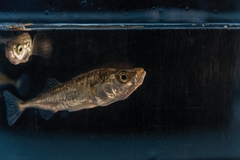Feb 4 2015
Bremerhaven/Sylt, 3rd February 2015. Researchers at the Alfred Wegener Institute, Helmholtz Centre for Polar and Marine Research (AWI) have shown that three-spined sticklebacks in the North Sea pass on information concerning their living environment to their offspring, without genetic changes.
This could play an important role in the species´ ability to adapt to the effects of climate change, as AWI experts report in a recently published study in the journal Functional Ecology. Interestingly, this information transfer appears to be primarily the mother's responsibility; in this study, the father's temperature experiences were much less significant.
 Sticklebacks (Gasterosteus aculeatus) (Photo: Alfred Wegener Institute
Sticklebacks (Gasterosteus aculeatus) (Photo: Alfred Wegener Institute
Climate change and the accompanying warming of the oceans are of key interest to researchers around the globe. Above all, they want to know: What will happen to marine life forms if the predicted changes become a reality? Will the various species be able to adapt to the rising water temperatures? In an effort to answer these questions, Dr Lisa Shama and Dr Mathias Wegner from the AWI-Sylt examined three-spined sticklebacks (Gasterosteus aculeatus) taken from the Wadden Sea off the coast of Sylt.
Over the course of several months of laboratory testing, they investigated whether the environmental experiences gathered by the parent fish alone can influence growth rates of their offspring. "Our focus wasn't on genetic heredity, but instead on gene-independent information transfer. Because if these effects can be confirmed, they could play an important part in coping with the effects of rapid climate changes," says biologist Mathias Wegner.
The point of departure for the study: The North Sea is growing warmer
For the North Sea, a habitat for marine populations of three-spined stickleback, climate models predict a rise in mean summer water temperatures of up to 4 degrees Celsius by the year 2100. In concrete terms, this will be a rise from 17 degrees to 21 degrees. "The three-spined stickleback is ideal for looking into this type of environmental change," explains AWI biologist Lisa Shama, the first author of the study. "First of all, the species can be found throughout the Northern Hemisphere. Secondly, in the past it has had to adapt to a range of different environmental conditions. And thirdly, the fish are easy to breed and can be kept in the lab over several generations."
In their experiments, Lisa Shama and Mathias Wegner kept female and male sticklebacks in either 17- or 21-degree-warm water. After two months, the fish were then mated within and between their acclimation temperatures. Sticklebacks use external fertilisation to reproduce: eggs and sperm only come into contact in the water. Using artificial fertilisation, multiple families of fertilised eggs (several parent couples) for each test group were produced, ensuring that each test group contained offspring of different parents, allowing the researchers to rule out genetic effects. "Knowing the genetic background of each offspring allows us to separate genetic effects from environmental effects", explains Lisa Shama.
The offspring from each family were subsequently raised in 17- or 21-degree-warm water in order to separate the acute effects of their own environment from those passed on by their mothers and fathers environment. After 30 days, offspring that grew in water with the same temperature as their mothers displayed the best growth rates. "This finding told us that, when looking for the source of the information-sharing, we could concentrate on the females," explains Mathias Wegner.
The researchers ultimately found the answer in the mitochondria, the "power plants" of cells, which are exclusively passed on to the next generation through the female's eggs. Each egg cell contains thousands of mitochondria, equipping the embryo to immediately commence with its development. Working together with Dr Felix Mark and Dr Anneli Strobel from the AWI-Bremerhaven, the biologists were able to show that the mitochondria in young fish's heart muscle consume less energy if they live in the same temperature of water as their mothers did.
With regard to the stickleback, this insight means: Offspring that live in the same conditions as their mothers showed optimised energy consumption in their heart muscle, i.e., an optimised metabolism. "Through her mitochondria, the mother shares information on the environment with her offspring," summarises Lisa Shama. "This also produces a lasting effect, even if the offspring's growth is primarily determined by their own environment," adds Mathias Wegner.
This is confirmed by their observations: After 60 days all groups tested displayed better growth at 17 than at 21 degrees. However, the maternal effects could still be clearly seen in the more stressful environment (21 degrees), whereas the paternal effects had a negligible influence on offspring growth.
The conclusion: The information is stored in the mitochondria
Recapping the study's findings, Mathias Wegner states, "Female sticklebacks pass on optimised mitochondria, which have adapted to the environmental conditions the mothers experienced, to their offspring. As a result the young fish receive information on their mothers' environment and living conditions without any genetic changes. In this species, then, maternal effects play a decisive role in terms of the potential to adapt to changes in their habitat."
This mechanism works particularly well in less favourable environments - which for sticklebacks means in warmer waters. According to Lisa Shama, "We can then conclude that the information-sharing mechanism - passing on the optimally acclimated mitochondria - represents a selective advantage and is likely the result of evolution."